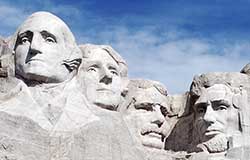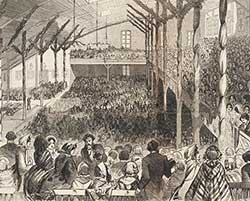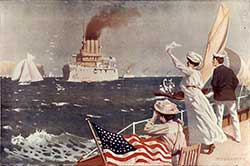Where Is Abraham Lincoln When We Need Him?

It’s a presidential election year and, as the political discourse turns increasingly personal and puerile, many of us long for the days when statesmen stood for election and spoke to the issues. So let’s look to the pantheon of American leaders and see how the men on Mount Rushmore really behaved.
George Washington. As the father of our country Washington didn’t have to run for president, he was chosen unanimously by the Electoral College. But as a young man he had to compete like everyone else — the first time, he lost.
Smarting from defeat, Washington ran again in 1758. Rather than campaign in person and intoxicate the electorate with his rhetoric, he used booze. His election-day liquor bill was for 34 gallons of wine, 3 pints of brandy, 13 gallons of beer, 8 quarts of cider and 40 gallons of rum punch. There were only 397 voters — it must have been a fun election. Washington won in a landslide.2
Thomas Jefferson. Washington’s 1758 election was a local affair and he was young. Surely vice president Thomas Jefferson wouldn't waste his time on such silliness. Correct, the campaign of character assassination he orchestrated was far from silly and would make the authors of today’s attack ads blush.
His first target was Treasury Secretary Alexander Hamilton. Jefferson’s agent, James Callender, accused Hamilton of having an affair with a married woman and then trying to buy the silence of her husband with insider secrets and Treasury funds. The attack then turned to Jefferson’s arch-rival, president John Adams,3 who was accused of being being “mentally deranged,” planning to crown himself king and grooming his son John Quincy to inherit the throne. Jefferson beat Adams in the 1800 election.
Callender got paid, but he wanted more, specifically a postmaster’s job. Scorned by Jefferson, he went to work for the enemy, disclosing Jefferson’s payments for the attack articles and his affair with his slave Sally Hemings.
Abraham Lincoln. Honest Abe, of course, was above such skullduggery — he’s the one who ended slavery and saved the Union.

True, but first he had to get elected, and in 1860 things didn’t look good. The favorite for the Republican nomination was William Seward. Luckily for Abe the convention was in Chicago, where sharp-elbowed politics was an art even in 1860.
On the day of the final vote, Seward’s supporters paraded to the convention accompanied by a marching band. They should have taken a shorter route, for when they arrived the hall was packed and many couldn’t get in. Lincoln’s supporters had arrived early, some with counterfeit tickets they had printed the night before.
At the end of the first ballot, Seward had more votes, but Lincoln’s masses made more noise. As voting proceeded, their cheers swayed wavering delegates. Lincoln was nominated on the third ballot.5
Even as a young legislator, Lincoln knew how to play the political game. He once jumped out of a second-floor window after the doors to the chamber were locked to maintain a quorum.

Theodore Roosevelt. That brings us to Teddy Roosevelt. Hardly one to shrink from controversy he often wrangled with Congress and exercised executive authority as he saw fit. Sound familiar?
Roosevelt undertook a massive expansion of the Navy. In 1907 he decided to sail the fleet around the world, both to show the flag and practice long-range operations. The voyage was planned in secret. In Roosevelt’s own words: “I determined on the move without consulting the Cabinet, precisely as I took Panama without consulting the Cabinet.”
Congress threatened to withhold funding when the voyage was announced. Roosevelt responded that he already had enough money to get the fleet to the Pacific and, if Congress choose not to fund its return, it would stay there. Roosevelt notes in his autobiography: “There was no further difficulty about the money.”7
* * * * *
The more things change, the more they stay the same, or so it’s often said. The men on Mount Rushmore are remembered for what they did, not how they did it. They won't be running in 2016, but odds are good that if they were, they would give as good as they got.
-----
- Mount Rushmore. Image by Bbadgett from Wikipedia.
- Chernow, Ron. Washington: A Life. New York: Penguin Press, 2010. pp 88-89.
- Modern readers may wonder how rivals could end up as president and vice president. In those days the vice presidency went to the presidential candidate who came in second, as Jefferson did in 1796. The current system was introduced by the Twelfth Amendment in 1804.
- The Republicans in Nominating Convention, from Harpers Weekly, May 19, 1860. Image from Library of Congress.
- Goodwin, Doris Kearns. Team of Rivals: The Political Genius of Abraham Lincoln. New York: Simon & Schuster, 2005. pp 247-249
- Welcoming the U.S. Atlantic Fleet to Sydney, Australia, from supplement to The Sydney Mail, August 19, 1908. Image from U.S. Naval Historical Center.
- Roosevelt, Theodore. Theodore Roosevelt: An Autobiography. New York: Macmillan Company, 1913. pp. 592-98.
This article originally appeared in our free semi-monthly newsletter. To receive future issues, please add your name to the subscription list.

